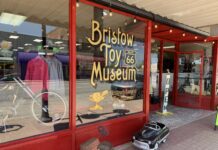To the uninitiated, navigating downtown Tulsa’s streets can be a challenging proposition. With a seemingly random array of one-way streets joined with two-way thoroughfares, finding one’s way to an intended destination in the heart of Oklahoma’s second-largest city can fray nerves.
Yet it is what happens after arrival at a destination that frustrates both the occasional visitor and seasoned downtown denizen alike. Finding the ideal place to park can either make or break one’s view toward Tulsa’s downtown. With private and public parking areas spread across a wide swath of downtown, the parking proposition often boils down to a question of proximity and physical stamina. It is a quandary that has not gone unnoticed by both public and private parking administrators and one that both view as one of the most important issues facing Tulsa’s vibrant and growing downtown.
Space: The New Frontier
“The challenge is to change the mindset and start dealing with parking like any other infrastructure,” says Tulsa Parking Authority (TPA) Director David Giacomo. “As a whole, it doesn’t take much more pressure in a system to make you have to add more spaces.”
Citing census figures, Giacomo says downtown Tulsa plays host to 30,041 in-bound commuters daily, while serving these commuters with 22,345 privately administered parking spaces. These private parking slots are augmented by 7,696 public parking spaces. Of these public parking spaces, 1,696 are metered parking.
Despite a robust surge in downtown residential dwellings, downtown Tulsa’s parking industry is a day game, dictated by the ups and downs of a commercial area that, despite Tulsa’s loss of the title “Oil Capitol of the World,” remains exposed to the fickle nature of the oil and gas industry. As the energy sector steadily recovered from the jolt of 2008’s economic recession, Giacomo says a visual gauge of the recovery can be seen in the number of occupied public slots in the heart of downtown’s traditional business areas. “We have noticed an increase in occupancy in what we call the ‘super block.’” The “super block” area, Giacomo explains, is the area surrounding the Bank of Oklahoma Tower.
With the heart of the business district straddling Boston Avenue from approximately Sixth Street and stretching to First Street, Giacomo says one of the biggest liabilities facing the city’s public parking offerings isn’t so much one of availability as it is one of access. “The reality is it’s too far from anywhere,” he says, pointing to what he describes as underutilized surface lots on downtown’s southern boundaries as an example. “It’s a little bit far from the core of downtown.”
For private parking companies such as Central Parking, proximity to the action has proven a lucrative and enduring endeavor. Operating approximately 4,500 spaces in the heart of downtown’s business district, Standard Parking Corporation Executive Vice President Mike Wolf says his company’s Central Parking division has enjoyed a presence in downtown that has endured for well over three decades. The surge in oil and gas industry activity has had a positive impact on his company’s Tulsa operations, as well. “As the Tulsa economy has grown over the last 48 months, we have definitely seen an increase in demand for parking,” he says. With the Tulsa area shielded from the full fury of the economic cyclone that lashed the nation nearly five years ago, Central Parking’s growth represents a continuation of a trend brought about by Tulsa’s newfound affinity for all things downtown that began at the turn of the century.
Stay And Play
Not so long ago, the area stretching from Brady on the west to Greenwood on the east, and with a southern boundary of First Street extending north to I-244, stood as a shining example of an area grasping at any semblance of life that might come its way. After a little vision met up with some old-school desire, the area now proudly holds the distinction as one of downtown Tulsa’s go-to places for seemingly limitless entertainment options. Home to one of the best minor league baseball venues in the country, in the form of ONEOK Field, and the chic Brady Arts District, the area has proven both a source of opportunity and challenge where parking is concerned.
“Brady is a funny area,” Giacomo concedes. “I think there’s a big potential in Brady.” With the recent relocation of KOTV television’s studios to the Brady area from its long-time home at the corner of Second and Elgin, the business aspect long associated with the area south of First Street has finally crossed the railroad tracks that served as something of a dividing line in downtown thinking, and it has forced parking planners to analyze and reanalyze the needs of Tulsa’s new “it” area. “I think we have done six studies, and they are ongoing,” Giacomo adds.
The private sector is keeping a close eye on the Brady District, as well. With a tight parking market also comes the inevitable plea for more spaces. And often, that involves a plea for additional parking garages. “To build a garage, a lot goes into the thought process,” Giacomo says. “A garage cannot pay for itself.” Monthly garage parking fees range from $85 to $130 per month, he explains, and are determined by a use-demand formula.
“Whether, and how much, the increased demand actually benefits any particular parking garage actually depends on the exact location of the demand, the hours when the demand exists and the number of parking spaces available in the area at that time,” Wolf says.
As downtown Tulsa’s entertainment offerings have blossomed, a new class of permanent downtown residents has followed the fun. And parking planners have taken notice. “Residential growth in downtown has certainly helped contribute to the overall growth in downtown Tulsa. As Tulsa continues to grow, we normally would expect to see additional parking demand as a result,” Wolf says. “As that occurs, we will continue to pursue opportunities that would align with our business model.”
“It depends on the demand generator,” Giacomo says of any potential parking garage construction. “We’ve had a lot of inquiry about residentials.” Giacomo explains that recent residential conversions have put pressure on a parking garage at Fourth Street and Boulder, and new construction on Archer Street is expected to put additional pressure on already-tight parking inventories in the Brady District.
A Soft Landing
The brave face of Tulsa’s revived downtown and its continuing mission to join the big leagues of American cities remains a work in progress. As downtown Tulsa continues to develop its 21st century identity, infrastructure issues will rear their heads now and then. Parking infrastructure challenges are a symptom of a downtown awakening after a decades-long nap. Although absent from any official plans in the short-term, innovations such as the construction of new garages to meet the needs of new residential developments and shuttles to facilitate business commutes from downtown’s southern extremes into the heart of Tulsa’s business world may someday prove viable resources. It’s simply a question of when and how.

























